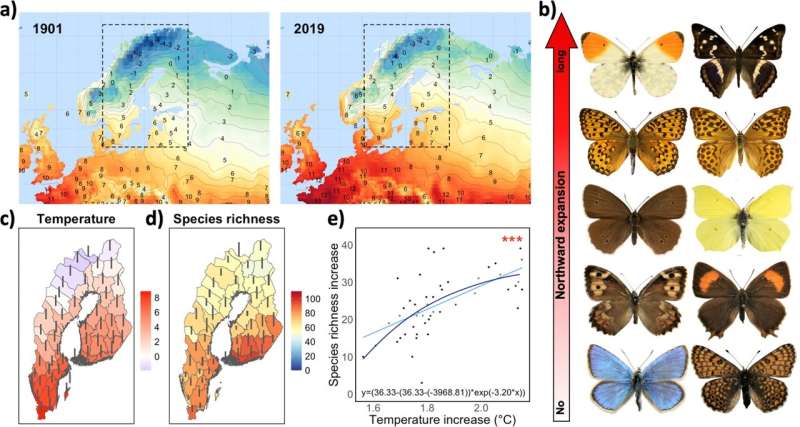This article has been reviewed according to Science X's editorial process and policies. Editors have highlighted the following attributes while ensuring the content's credibility:
fact-checked
peer-reviewed publication
trusted source
proofread
Climate change has increased diversity of butterflies in Sweden and Finland, may have major ecosystem consequences

New research shows that butterflies have expanded their ranges over the past 120 years to cope with a warmer climate in Sweden and Finland. Although driven by a warmer climate, range expansions have also been influenced by human land use and vary according to species thermal tolerances and habitat preferences. The increased species richness and modified community composition of butterflies may impact ecosystem functioning.
Climate change imposes challenges for biodiversity worldwide. The consequences and responses to the altered conditions for life vary among geographic regions and organisms.
A comprehensive study led by an international team of researchers from Linnaeus University, Lund University, University of Gävle and Finnish Environment Institute (SYKE) has unveiled fascinating insights into the effects of climate change on biodiversity.
"We were interested in how the spatial distributions of these beautiful creatures have shifted during the last 120 years as a result of the modified challenges and conditions that characterize our changing world," explains Johanna Sunde, the study's lead author and researcher at Linnaeus University.
The research, published in Communications Biology, explores how climate change, land use, and species characteristics have influenced species range shift distributions over the past 120 years, focusing on 131 butterfly species in Sweden and Finland.
Effects of changes in temperature and land use
The researchers discovered that butterfly species richness has increased by 64% on average, from 46 to 70 species per province, suggesting that these species have been steadily shifting their ranges northwards, in part due to increasing temperatures. However, these shifts are not solely determined by rising temperatures. Instead, changes in land use and differences in specific species traits have also significantly influenced the movements.
"Environmental change does not just affect temperatures—it also alters land use and species interactions. Understanding these relationships will be crucial as we continue to grapple with the effects of global warming," Johanna Sunde says.
The study results underscore the complexity of ecological responses to climate change and the importance of considering a broad range of factors when planning for biodiversity conservation and ecosystem management. Through their intricate dance of adaptation and resilience, butterflies illustrate the interconnectedness of life and the environment.
"We hope that our findings will encourage a broader ecological perspective on climate change impacts, emphasizing the need to consider climate factors and changes in land use and species characteristics. We are literally watching the story of resilience and adaptation unfold through the lives of these butterflies," adds Sunde.
More information: Johanna Sunde et al, Century-long butterfly range expansions in northern Europe depend on climate, land use and species traits, Communications Biology (2023). DOI: 10.1038/s42003-023-04967-z
Journal information: Communications Biology
Provided by Linnaeus University





















